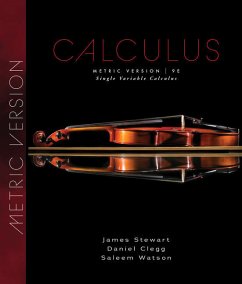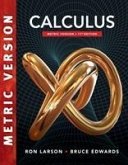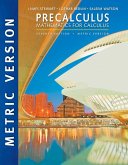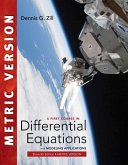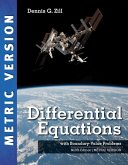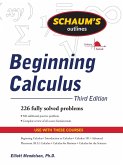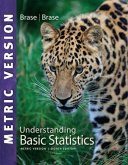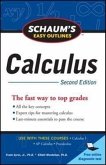James Stewart (McMaster University and University of Toronto), Daniel K. Clegg (Palomar College), Saleem Watson (Long Beach California State University)
Single Variable Calculus, Metric Edition
James Stewart (McMaster University and University of Toronto), Daniel K. Clegg (Palomar College), Saleem Watson (Long Beach California State University)
Single Variable Calculus, Metric Edition
- Gebundenes Buch
- Merkliste
- Auf die Merkliste
- Bewerten Bewerten
- Teilen
- Produkt teilen
- Produkterinnerung
- Produkterinnerung
SINGLE VARIABLE CALCULUS, Metric, 9th Edition, provides you with the strongest foundation for a STEM future. James Stewart's Calculus series is the top-seller in the world because of its problem-solving focus, mathematical precision and accuracy, and outstanding examples and problem sets. Selected and mentored by Stewart, Daniel Clegg and Saleem Watson continue his legacy and their careful refinements retain Stewart's clarity of exposition and make the 9th edition an even more usable learning tool. The accompanying WebAssign includes helpful learning support and new resources like Explore It…mehr
Andere Kunden interessierten sich auch für
![Calculus, International Metric Edition Calculus, International Metric Edition]() Ron Larson (The Behrend College The Pennsylvania State University)Calculus, International Metric Edition117,99 €
Ron Larson (The Behrend College The Pennsylvania State University)Calculus, International Metric Edition117,99 €![Precalculus: Mathematics for Calculus, International Metric Edition Precalculus: Mathematics for Calculus, International Metric Edition]() Lothar Redlin (Abington Campus Pennsylvania State University)Precalculus: Mathematics for Calculus, International Metric Edition100,99 €
Lothar Redlin (Abington Campus Pennsylvania State University)Precalculus: Mathematics for Calculus, International Metric Edition100,99 €![A First Course in Differential Equations with Modeling Applications, International Metric Edition A First Course in Differential Equations with Modeling Applications, International Metric Edition]() Dennis Zill (Loyola Marymount University)A First Course in Differential Equations with Modeling Applications, International Metric Edition114,99 €
Dennis Zill (Loyola Marymount University)A First Course in Differential Equations with Modeling Applications, International Metric Edition114,99 €![Differential Equations with Boundary-Value Problems, International Metric Edition Differential Equations with Boundary-Value Problems, International Metric Edition]() Dennis Zill (Loyola Marymount University)Differential Equations with Boundary-Value Problems, International Metric Edition105,99 €
Dennis Zill (Loyola Marymount University)Differential Equations with Boundary-Value Problems, International Metric Edition105,99 €![Schaum's Outline of Beginning Calculus, Third Edition Schaum's Outline of Beginning Calculus, Third Edition]() Elliott MendelsonSchaum's Outline of Beginning Calculus, Third Edition31,99 €
Elliott MendelsonSchaum's Outline of Beginning Calculus, Third Edition31,99 €![Understanding Basic Statistics, International Metric Edition Understanding Basic Statistics, International Metric Edition]() Charles Henry Brase (.)Understanding Basic Statistics, International Metric Edition96,99 €
Charles Henry Brase (.)Understanding Basic Statistics, International Metric Edition96,99 €![Schaum's Easy Outline of Calculus, Second Edition Schaum's Easy Outline of Calculus, Second Edition]() Elliott MendelsonSchaum's Easy Outline of Calculus, Second Edition18,99 €
Elliott MendelsonSchaum's Easy Outline of Calculus, Second Edition18,99 €-
-
-
SINGLE VARIABLE CALCULUS, Metric, 9th Edition, provides you with the strongest foundation for a STEM future. James Stewart's Calculus series is the top-seller in the world because of its problem-solving focus, mathematical precision and accuracy, and outstanding examples and problem sets. Selected and mentored by Stewart, Daniel Clegg and Saleem Watson continue his legacy and their careful refinements retain Stewart's clarity of exposition and make the 9th edition an even more usable learning tool. The accompanying WebAssign includes helpful learning support and new resources like Explore It interactive learning modules. Showing that Calculus is both practical and beautiful, the Stewart approach and WebAssign resources enhance understanding and build confidence for millions of students worldwide.
Hinweis: Dieser Artikel kann nur an eine deutsche Lieferadresse ausgeliefert werden.
Hinweis: Dieser Artikel kann nur an eine deutsche Lieferadresse ausgeliefert werden.
Produktdetails
- Produktdetails
- Verlag: Brooks Cole / Cengage Learning EMEA
- 9. Aufl.
- Seitenzahl: 992
- Erscheinungstermin: 2. Juni 2020
- Englisch
- Abmessung: 225mm x 261mm x 40mm
- Gewicht: 2056g
- ISBN-13: 9780357113479
- ISBN-10: 0357113470
- Artikelnr.: 59563083
- Herstellerkennzeichnung
- Libri GmbH
- Europaallee 1
- 36244 Bad Hersfeld
- gpsr@libri.de
- Verlag: Brooks Cole / Cengage Learning EMEA
- 9. Aufl.
- Seitenzahl: 992
- Erscheinungstermin: 2. Juni 2020
- Englisch
- Abmessung: 225mm x 261mm x 40mm
- Gewicht: 2056g
- ISBN-13: 9780357113479
- ISBN-10: 0357113470
- Artikelnr.: 59563083
- Herstellerkennzeichnung
- Libri GmbH
- Europaallee 1
- 36244 Bad Hersfeld
- gpsr@libri.de
Preface.To the Student.Diagnostic Tests.A Preview of Calculus.1. FUNCTIONS AND MODELS.Four Ways to Represent a Function. Mathematical Models: A Catalog of Essential Functions. New Functions from Old Functions. Exponential Functions. Inverse Functions and Logarithms. Review. Principles of Problem Solving.2. LIMITS AND DERIVATIVES.The Tangent and Velocity Problems. The Limit of a Function. Calculating Limits Using the Limit Laws. The Precise Definition of a Limit. Continuity. Limits at Infinity; Horizontal Asymptotes. Derivatives and Rates of Change. Writing Project: Early Methods for Finding Tangents. The Derivative as a Function. Review. Problems Plus.3. DIFFERENTIATION RULES.Derivatives of Polynomials and Exponential Functions. Applied Project: Building a Better Roller Coaster. The Product and Quotient Rules. Derivatives of Trigonometric Functions. The Chain Rule. Applied Project: Where Should a Pilot Start Descent? Implicit Differentiation. Discovery Project: Families of Implicit Curves. Derivatives of Logarithmic Functions and Inverse Trigonometric Functions. Rates of Change in the Natural and Social Sciences. Exponential Growth and Decay. Applied Project: Controlling Red Blood Cell Loss During Surgery. Related Rates. Linear Approximations and Differentials. Discovery Project: Taylor Polynomials. Hyperbolic Functions. Review. Problems Plus.4. APPLICATIONS OF DIFFERENTIATION.Maximum and Minimum Values. Applied Project: The Calculus of Rainbows. The Mean Value Theorem. What Derivatives Tell Us about the Shape of a Graph. Indeterminate Forms and l'Hospital's Rule. Writing Project: The Origins of l'Hospital's Rule. Summary of Curve Sketching. Graphing with Calculus and Technology. Optimization Problems. Applied Project: The Shape of a Can. Applied Project: Planes and Birds: Minimizing Energy. Newton's Method. Antiderivatives. Review. Problems Plus.5. INTEGRALS.The Area and Distance Problems. The Definite Integral. Discovery Project: Area Functions. The Fundamental Theorem of Calculus. Indefinite Integrals and the Net Change Theorem. Writing Project: Newton, Leibniz, and the Invention of Calculus. The Substitution Rule. Review. Problems Plus.6. APPLICATIONS OF INTEGRATION.Areas Between Curves. Applied Project: The Gini Index. Volumes. Volumes by Cylindrical Shells. Work. Average Value of a Function. Applied Project: Calculus and Baseball. Applied Project: Where to Sit at the Movies. Review. Problems Plus.7. TECHNIQUES OF INTEGRATION.Integration by Parts. Trigonometric Integrals. Trigonometric Substitution. Integration of Rational Functions by Partial Fractions. Strategy for Integration. Integration Using Tables and Technology. Discovery Project: Patterns in Integrals. Approximate Integration. Improper Integrals. Review. Problems Plus.8. FURTHER APPLICATIONS OF INTEGRATION.Arc Length. Discovery Project: Arc Length Contest. Area of a Surface of Revolution. Discovery Project: Rotating on a Slant. Applications to Physics and Engineering. Discovery Project: Complementary Coffee Cups. Applications to Economics and Biology. Probability. Review. Problems Plus.9. DIFFERENTIAL EQUATIONS.Modeling with Differential Equations. Direction Fields and Euler's Method. Separable Equations. Applied Project: How Fast Does a Tank Drain? Models for Population Growth. Linear Equations. Applied Project: Which is Faster, Going Up or Coming Down? Predator-Prey Systems. Review. Problems Plus.10. PARAMETRIC EQUATIONS AND POLAR COORDINATES.Curves Defined by Parametric Equations. Discovery Project: Running Circles Around Circles. Calculus with Parametric Curves. Discovery Project: Bézier Curves. Polar Coordinates. Discovery Project: Families of Polar Curves. Calculus in Polar Coordinates. Conic Sections. Conic Sections in Polar Coordinates. Review. Problems Plus.11. SEQUENCES, SERIES, AND POWER SERIES.Sequences. Discovery Project: Logistic Sequences. Series. The Integral Test and Estimates of Sums. The Comparison Tests. Alternating Se
Preface.To the Student.Diagnostic Tests.A Preview of Calculus.1. FUNCTIONS AND MODELS.Four Ways to Represent a Function. Mathematical Models: A Catalog of Essential Functions. New Functions from Old Functions. Exponential Functions. Inverse Functions and Logarithms. Review. Principles of Problem Solving.2. LIMITS AND DERIVATIVES.The Tangent and Velocity Problems. The Limit of a Function. Calculating Limits Using the Limit Laws. The Precise Definition of a Limit. Continuity. Limits at Infinity; Horizontal Asymptotes. Derivatives and Rates of Change. Writing Project: Early Methods for Finding Tangents. The Derivative as a Function. Review. Problems Plus.3. DIFFERENTIATION RULES.Derivatives of Polynomials and Exponential Functions. Applied Project: Building a Better Roller Coaster. The Product and Quotient Rules. Derivatives of Trigonometric Functions. The Chain Rule. Applied Project: Where Should a Pilot Start Descent? Implicit Differentiation. Discovery Project: Families of Implicit Curves. Derivatives of Logarithmic Functions and Inverse Trigonometric Functions. Rates of Change in the Natural and Social Sciences. Exponential Growth and Decay. Applied Project: Controlling Red Blood Cell Loss During Surgery. Related Rates. Linear Approximations and Differentials. Discovery Project: Taylor Polynomials. Hyperbolic Functions. Review. Problems Plus.4. APPLICATIONS OF DIFFERENTIATION.Maximum and Minimum Values. Applied Project: The Calculus of Rainbows. The Mean Value Theorem. What Derivatives Tell Us about the Shape of a Graph. Indeterminate Forms and l'Hospital's Rule. Writing Project: The Origins of l'Hospital's Rule. Summary of Curve Sketching. Graphing with Calculus and Technology. Optimization Problems. Applied Project: The Shape of a Can. Applied Project: Planes and Birds: Minimizing Energy. Newton's Method. Antiderivatives. Review. Problems Plus.5. INTEGRALS.The Area and Distance Problems. The Definite Integral. Discovery Project: Area Functions. The Fundamental Theorem of Calculus. Indefinite Integrals and the Net Change Theorem. Writing Project: Newton, Leibniz, and the Invention of Calculus. The Substitution Rule. Review. Problems Plus.6. APPLICATIONS OF INTEGRATION.Areas Between Curves. Applied Project: The Gini Index. Volumes. Volumes by Cylindrical Shells. Work. Average Value of a Function. Applied Project: Calculus and Baseball. Applied Project: Where to Sit at the Movies. Review. Problems Plus.7. TECHNIQUES OF INTEGRATION.Integration by Parts. Trigonometric Integrals. Trigonometric Substitution. Integration of Rational Functions by Partial Fractions. Strategy for Integration. Integration Using Tables and Technology. Discovery Project: Patterns in Integrals. Approximate Integration. Improper Integrals. Review. Problems Plus.8. FURTHER APPLICATIONS OF INTEGRATION.Arc Length. Discovery Project: Arc Length Contest. Area of a Surface of Revolution. Discovery Project: Rotating on a Slant. Applications to Physics and Engineering. Discovery Project: Complementary Coffee Cups. Applications to Economics and Biology. Probability. Review. Problems Plus.9. DIFFERENTIAL EQUATIONS.Modeling with Differential Equations. Direction Fields and Euler's Method. Separable Equations. Applied Project: How Fast Does a Tank Drain? Models for Population Growth. Linear Equations. Applied Project: Which is Faster, Going Up or Coming Down? Predator-Prey Systems. Review. Problems Plus.10. PARAMETRIC EQUATIONS AND POLAR COORDINATES.Curves Defined by Parametric Equations. Discovery Project: Running Circles Around Circles. Calculus with Parametric Curves. Discovery Project: Bézier Curves. Polar Coordinates. Discovery Project: Families of Polar Curves. Calculus in Polar Coordinates. Conic Sections. Conic Sections in Polar Coordinates. Review. Problems Plus.11. SEQUENCES, SERIES, AND POWER SERIES.Sequences. Discovery Project: Logistic Sequences. Series. The Integral Test and Estimates of Sums. The Comparison Tests. Alternating Se

